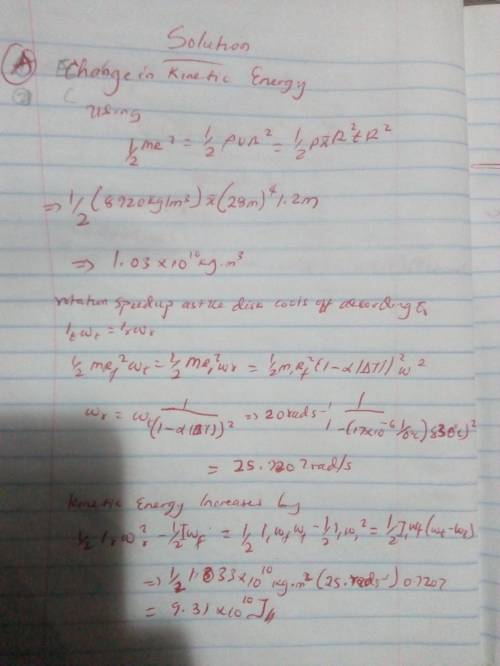
Physics, 01.08.2020 01:01, therronvictorjr
Following a collision between a large spacecraft and an asteroid, a copper disk of radius 28.0 m and thickness 1.20 m, at a temperature of 850°C, is floating in space, rotating about its axis with an angular speed of 20.0 rad/s. As the disk radiates infrared light, its temperature falls to 20.0°C. No external torque acts on the disk.
A) Find the change in kinetic energy of the disk.
B) Find the change in internal energy of the disk.
C) Find the amount of energy it radiates.

Answers: 2
Other questions on the subject: Physics

Physics, 21.06.2019 18:50, gutierrezaandrea56
Study the following reaction carefully. what classification should this reaction have? 4al + 3o2 2al2o3synthesisdecompositionsingle replacementdouble displacement
Answers: 1


Physics, 22.06.2019 19:30, CalCDanG
Assume that two of the electrons at the negative terminal have attached themselves to a nearby neutral atom. there is now a negative ion with a charge -2e at this terminal. what are the electric potential and electric potential energy of the negative ion relative to the electron? the electric potential and the electric potential energy are both twice as much. the electric potential is twice as much and the electric potential energy is the same. the electric potential is the same and the electric potential energy is twice as much. the electric potential and the electric potential energy are both the same. the electric potential is the same and the electric potential energy is increased by the mass ratio of the oxygen ion to the electron. the electric potential is twice as much and the electric potential energy is increased by the mass ratio of the oxygen ion to the electron.
Answers: 3

Physics, 22.06.2019 20:30, valenzueladomipay09u
Light from two different sources are incident upon the same side of a polarizing filter. light from one source is polarized with total intensity ip, while light from the other source is unpolarized with total intensity iu. as you rotate the polarizing filter through 360 degrees, the intensity of the transmitted light on the other side varies by a factor of 9. what is the relative intensity of the initial polarized source to the unpolarized source, or ip/iu?
Answers: 2
Do you know the correct answer?
Following a collision between a large spacecraft and an asteroid, a copper disk of radius 28.0 m and...
Questions in other subjects:





Physics, 14.04.2020 16:09



Mathematics, 14.04.2020 16:09









